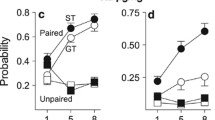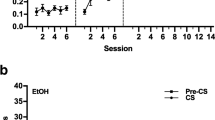Abstract
Sedative and facilitatory effects on variable-interval hypothalamic self-stimulation were monitored during chronic treatment with chlordiazepoxide (CDP; 7.5 mg/kg IP), given at 48-h intervals in two groups of rats. Group 1 was injected immediately before each of 40 1-h self-stimulation sessions (“drugged responding”); Group 2 was injected after self-stimulation for the first 20 sessions (“undrugged responding”), and before self-stimulation for a further 20 sessions (“drugged responding”). Significant sedation occurred in both groups in initial sessions of drugged responding, even though Group 2 had already received 20 injections of CDP (after undrugged sessions). Sedative effects showed very rapid tolerance, and disappeared after 1–3 sessions, but only in rats which had been responding while drugged (and which thus had had opportunities to develop coping strategies against the sedative effects). After further sessions of drugged responding, sedation was replaced by apparently stimulant effects. Stimulant effects showed no tolerance at all in either group even after 40 injections, thus differing from anti-conflict (and other) effects of BZDs, which generally show gradual tolerance. These results show that coping strategies acquired by instrumental learning can account for rapid and selective tolerance to sedative effects. Coping strategies do not account for the differing rates of tolerance to stimulant and to other effects of BZDs; these differences may indicate pharmacologically distinct brain systems downstream from the BZD receptor.
Similar content being viewed by others
References
Cook L, Sepinwall J (1975) Behavioral analysis of the effects and mechanisms of action of benzodiazepines. In: Costa E, Greengard P (eds) Mechanisms of action of benzodiazepines. Raven, New York, pp 1–28
De Groot J (1959) The rat forebrain in stereotaxic coordinates. Noord-Hollandsche Uitgevers, Amsterdam
Demellweek C, Goudie AJ (1983) Behavioural tolerance to amphetamine and other psychostimulants; the case for considering behavioural mechanisms. Psychopharmacology 80:287–307
File SE (1981) Rapid development of tolerance to the sedative effects of lorazepam and triazolam in rats. Psychopharmacology 73:240–245
File SE (1985) Tolerance to the behavioural actions of benzodiazepines. Neurosci Biobehav Rev 9:113–121
File SE, Pellow S (1985) No cross-tolerance between the stimulatory and depressant effects of benzodiazepines in mice. Behav Brain Res 17:1–7
Gerhardt S, Prowse J, Liebman JM (1982) Anxiolytic drugs selectively increase preferred duration of rewarding brain stimulation in a shuttlebox test. Pharmacol Biochem Behav 16:795–799
Goldberg ME, Manian AA, Efron DH (1967) A comparative study of certain pharmacological responses following acute and chronic administrations of chlordiazepoxide. Life Sci 6:481–491
Griffiths JW, Goudie AJ (1987) Analysis of the role of behavioural factors in the development of tolerance to the benzodiazepine midazolam. Neuropharmacology 26:201–210
Herberg LJ, Williams SF (1983) Anti-conflict and depressant effects of GABA agonists and antagonists, benzodiazepines and non-gabergic anticonvulsants on self-stimulation and locomotor activity. Pharmacol Biochem Behav 19:625–633
Koechlin BA, Schwartz MA, Krol G, Oberhansli W (1965) The metabolic fate of 14C-labeled chlordiazepoxide in man, in the dog, and in the rat. J Pharmacol Exp Ther 148:399–411
Liebman JM (1985) Anxiety, anxiolytics and brain stimulation reinforcement. Neurosci Biobehav Rev 9:75–86
McMillan E, Leander JD (1978) Chronic chlordiazepoxide and pentobarbital interaction on punished and unpunished behavior. J Pharmacol Exp Ther 207:515–520
Margules DL, Stein L (1968) Increase of antianxiety activity and tolerance to behavioral depression during chronic administration of oxazepam. Psychopharmacologia 13:74–80
Matsubara K, Matsushita A (1982) Changes in ambulatory activities and muscle relaxation in rats after repeated doses of diazepam. Psychopharmacology 77:279–283
Möhler H, Okada T (1977) Benzodiazepine receptors: demonstration in the CNS. Science 198:849–851
Panksepp J, Gandelman R, Trowill J (1970) Modulation of hypothalamic self-stimulation and escape behavior by chlordiazepoxide. Physiol Behav 5:965–969
Pellow S (1985) Can drug effects on anxiety and convulsions be separated? Neurosci Biobehav Rev 9:55–73
Pellow S, File SE, Herberg LJ (1984a) Intracranial self-stimulation distinguishes between two benzodiazepine antagonists. Neurosci Lett 47:173–177
Pellow S, Herberg LJ, File SE (1984b) The effect of the β-carboline FG 7142 on intracranial self-stimulation in the rat. Pharmacol Biochem Behav 21:667–669
Pellow S, Herberg LJ, File SE (1986) Antagonism of the effects of the atypical benzodiazepine, Ro 5–4864, on intracranial self-stimulation in the rat. Pharmacol Biochem Behav 24:193–197
Rose IC, Stolerman IP (1984) Discriminative stimulus effects of midazolam in rats. Br J Pharmacol 82:239P
Sanger DJ (1985) GABA and behavioural effects of anxiolytic drugs. Life Sci 36:1503–1513
Sansone M (1979) Effect of repeated administration of chlordiazepoxide on spontaneous locomotor activity in mice. Psychopharmacology 66:109–110
Sepinwall J, Cook L (1980) Mechanism of action of benzodiazepines: behavioral aspect. Fed Proc 39:3024–3031
Squires RF, Braestrup C (1977) Benzodiazepine receptors in rat brain. Nature 266:732–734
Stephens DN, Schneider HH (1985) Tolerance to the benzodiazepine diazepam in an animal model of anxiolytic activity. Psychopharmacology 87:322–327
Stephens DN, Kehr W, Wachtel H, Schmiechen R (1985) The anxiolytic activity of β-carboline derivatives in mice and its separation from ataxic properties. Pharmacopsychiatry 18:167–170
Treit D (1985) Evidence that tolerance develops to the anxiolytic effects of diazepam in rats. Pharmacol Biochem Behav 22:383–387
Vellucci SV, File SE (1979) Chlordiazepoxide loses its anxiolytic action with long-term treatment. Psychopharmacology 62:61–65
Author information
Authors and Affiliations
Rights and permissions
About this article
Cite this article
Herberg, L.J., Montgomery, A.M.J. Learnt tolerance to sedative effects of chlordiazepoxide on self-stimulation performance, but no tolerance to facilitatory effects after 80 days. Psychopharmacology 93, 214–217 (1987). https://doi.org/10.1007/BF00179936
Received:
Revised:
Issue Date:
DOI: https://doi.org/10.1007/BF00179936




